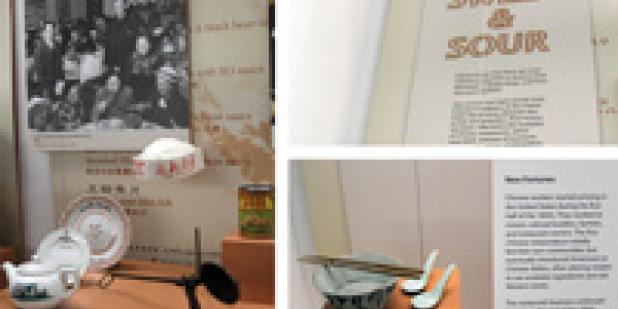Join us for a free one-day workshop for educators at the Japanese American National Museum, hosted by the USC U.S.-China Institute and the National Consortium for Teaching about Asia. This workshop will include a guided tour of the beloved exhibition Common Ground: The Heart of Community, slated to close permanently in January 2025. Following the tour, learn strategies for engaging students in the primary source artifacts, images, and documents found in JANM’s vast collection and discover classroom-ready resources to support teaching and learning about the Japanese American experience.
Sweet & Sour: A Look at the History of Chinese Food in the United States
The Smithsonian's National Museum of American History will present a Chinese American display, Sweet & Sour, opening March 17, 2011.
Where

The Sweet & Sour showcase represents a milestone within an ongoing initiative by the museum to focus on its Chinese American history and culture through collections. The project called for collecting a variety of Chinese restaurant-related objects ranging from menus, restaurant signs, and cooking tools. These items provide a glimpse into the long history of Chinese immigration, exclusion, exoticism, and perseverance.
The history of Chinese immigration dates back to the mid-1800s when Chinese workers arrived in the United States to work as miners, railroad builders, farmers, and laborers. The first Chinese restaurants were not opened by professionally trained chefs, but by immigrants who were denied work elsewhere or simply wished to feed their own communities. The Chinese restaurant business continued to expand throughout the early 1900s as Americans became intrigued with new exotic flavors at an inexpensive price. Chinese restaurant-owners found ways to combine their traditional recipes with Western flavors in order to attract more American customers. Chop suey, which means “little pieces,” quickly became a culinary trend. A combination of familiar ingredients such as meat, fish, vegetables, eggs, and sauce invited Americans to experience a new culture.
As more Chinese immigrants crossed the U.S. border around 1965, new recipes and flavors made their way into Chinese restaurant menus. Mixing old Cantonese-style cuisine with new dishes from the Szechuan and Hunan regions continued to spike American restaurant-goers interest in the food. Today, there are more than 41,000 Chinese restaurants in the United States.
Featured Articles
Please join us for the Grad Mixer! Hosted by USC Annenberg Office of International Affairs, Enjoy food, drink and conversation with fellow students across USC Annenberg. Graduate students from any field are welcome to join, so it is a great opportunity to meet fellow students with IR/foreign policy-related research topics and interests.
RSVP link: https://forms.gle/1zer188RE9dCS6Ho6
Events
Hosted by USC Annenberg Office of International Affairs, enjoy food, drink and conversation with fellow international students.
Join us for an in-person conversation on Thursday, November 7th at 4pm with author David M. Lampton as he discusses his new book, Living U.S.-China Relations: From Cold War to Cold War. The book examines the history of U.S.-China relations across eight U.S. presidential administrations.




